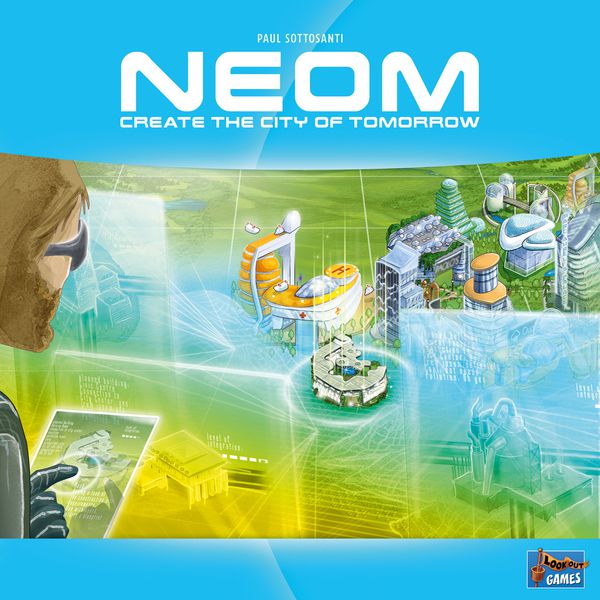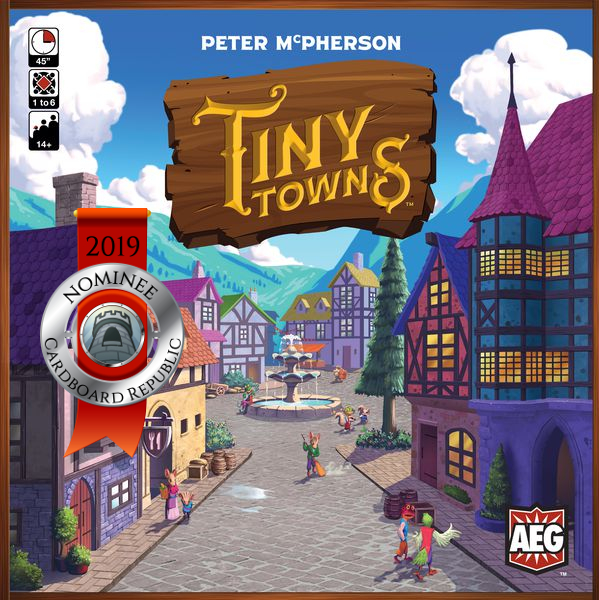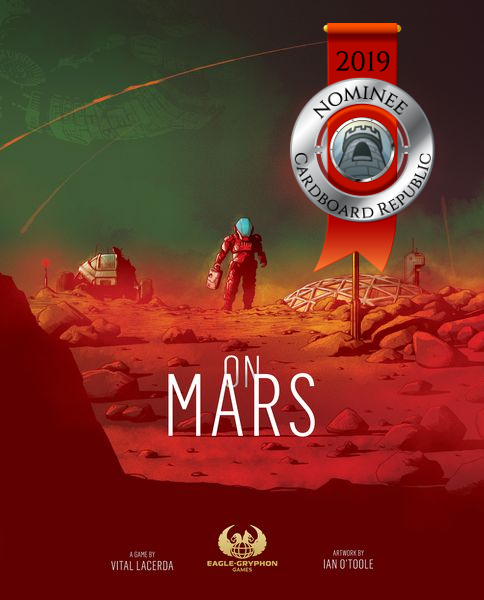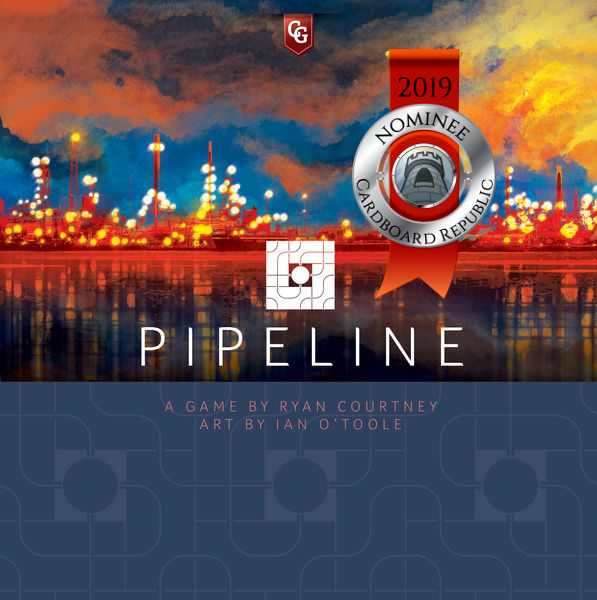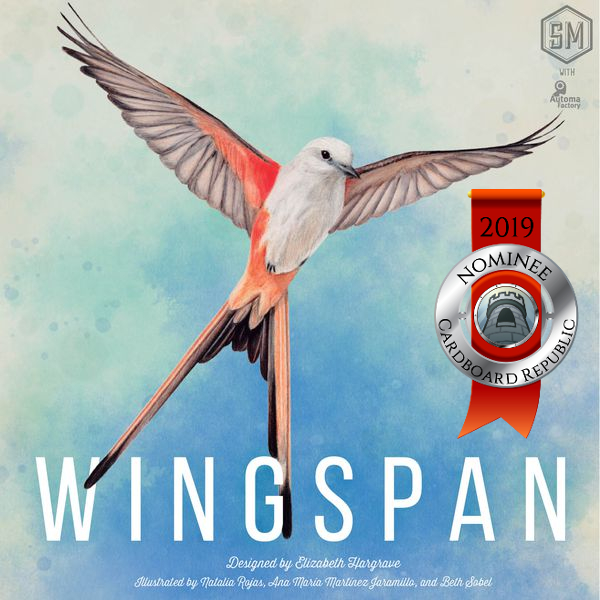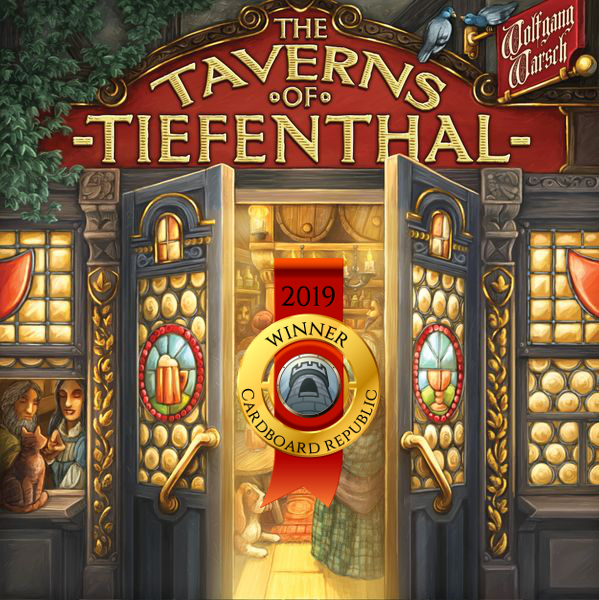The Cardboard Republic has rolled out the annual Laurels of the Republic awards, celebrating the best new games released in 2019 for each of the gamer archetypes. What follows are the finalists for one of those groups.
 Whether it’s amassing the largest armies, hoarding the most gold, or building the best village, Architects are always on the lookout to expand their sphere of influence as much as possible. These world builders thrive on games where they feel the game has a point and that the best way to secure victory has more options than simply cracking skulls. Careful, methodical, and always looking to trade short term goals for long term opportunities, games of this nature reward strategy, persistence, and a sense of progression more than anything else.
Whether it’s amassing the largest armies, hoarding the most gold, or building the best village, Architects are always on the lookout to expand their sphere of influence as much as possible. These world builders thrive on games where they feel the game has a point and that the best way to secure victory has more options than simply cracking skulls. Careful, methodical, and always looking to trade short term goals for long term opportunities, games of this nature reward strategy, persistence, and a sense of progression more than anything else.
And with that, here are The 2019 Laurel Finalists for Architects:
Honorable Mention: NEOM
Publisher: Lookout Games / Asmodee North America | Players: 1-5| Play Time: 45 Minutes
Thanks to its sprawling umbrella of distribution partners and publisher acquisitions, it’s hard to ignore the sheer number of titles released every year that are associated with Asmodee in some way, shape, or form. What is therefore surprising is when one of those titles flies conspicuously under the radar for so long that many people forgot that a exemplary was released by one of its flagship companies, let alone that the game itself even existed. NEOM is one such game.
Originally an Essen 2018 release, NEOM didn’t arrive stateside until around February. Despite some early praise prior to that point, its release was rather tepid, having to compete with a bevy of other releases at that time. NEOM’s popularity never quite burst out onto the scene like a lot of games. Instead, its appeal was more of a slow burn as more and more people heard about this game that’s one part 7 Wonders, one part SimCity.
NEOM is a tile drafting game centered around creating a model city of the future, with NEOM itself being a direct reference to the real world ‘smart city’ project currently underway in Saudi Arabia. Over the span of three generational rounds, players take turns drafting and placing tiles into their city grid. Placement of these tiles not only needs to conform to certain rules and resource prerequisites, but each tile scores differently based on where you put it. The more thoughtful you are when making your tile placements, the more productive your city will be at the end. Measured and weighted decision-making are essential to your city’s prosperity, especially as more powerful and futuristic tiles come online with each successive round.
NEOM also has a handful of disaster tiles to factor in as well, each of which causes negative impacts on other players instead. It’s not quite a monster attack or nuclear meltdown, but it’s still painful if precautions haven’t been taken.
All of which ties together into a tile-laying experience that seems tailor-made for Architects. Thanks to an approachable ruleset, a lightweight but substantive sense of progression, and their innate adoration for growth-based sim games, NEOM is one city this group will have no regrets making a day trip to.
The Nominees

Number Five: Tiny Towns
Publisher: Alderac Entertainment Group | Players: 1-6 | Play Time: 45-60 Minutes
Of all the driving characteristics behind what Architects find favorable, few are more important than having a sense of purpose. Why are you attacking that location? What is it exactly that we’re trading? Why should I be focused on this building? To them, expanding their influence isn’t just a puzzle to overcome; it must also include some practical explanation to justify those efforts. Even if that premise is as simple as creating a valuable city using as small a footprint, hoofprint, or clawprint as possible. Such as with the commendably concise Tiny Towns.
In Tiny Towns, you are the mayor of an itsy-bitsy village squirreled away in the woodlands. Your goal is to use the limited resources and minute scrap of land available to you to create the optimal urban blueprint. The catch is that much like any municipal bureaucracy, you don’t have complete control over the process.
Tiny Towns is essentially Tetris meets Bingo, with a heavy emphasis on spatial planning and a semi-public resource selection process. In it, each player takes a turn calling out one of the game’s various resources and adding that resource to one of the unoccupied spaces on your 4×4 city grid. Then, if you have correctly laid out the resources matching the pattern of one of the game’s randomized building cards, you replace them with a permanent structure. These buildings score you points based on location, adjacency, volume, and more. It also happens to be the only way to clear spaces from your board. When no one can place anything, the person with the most prosperous town at that moment wins.
Tiny Towns is undeniably the shortest and lightest game on this list, but it’s hardly devoid of meaningful expansion-based decisions. Every cube placed is a miniature exercise in city’s planning and development. It may not be as deep as games Architects usually thrive on, but Tiny Towns gallantly does something equally as important: providing an enticing means to scratch that city-building itch when something longer and more involved isn’t possible. It’s accessible, succinct, visually appealing, and manages to capture the essence of what world builders adore on a small scale. And in that regard, Tiny Towns is a big success.
Number Four: On Mars
Publisher: Eagle-Gryphon Games | Players: 1-4 | Play Time: 90-150 Minutes
Lacerda games are a known commodity at this point. Known for making highly involved, tightly-wound, and deeply strategic games with a thematic integration that take several playthroughs to fully get a handle on, you generally know what you’re getting into. And of his two titles released in 2019, On Mars is definitely the meatier of the two.
Which is to be expected really: no one said colonizing Mars was going to be easy.
At its most fundamental, On Mars is a worker placement game about the early stages of constructing a self-sustaining Mars base. Over the course of the game, players are competing companies looking to balance their company goals with that of the larger Mars mission. Accomplishing this is done by carefully directing their workers on a bifurcated board, with one half of the actions available only when you’re on the orbiting space station and the other half when you’re on the planet. Much of the game’s intrigue is determining the best moments to jump between the two. Through this maze of choices, players will develop technologies, harvest resources, construct buildings, and otherwise expand your influence on the colony – all of which is depicted with the usual highly polished flair his games have become known for.
On Mars can be restrictive at times with available options (a sandbox game this is not). Juggling the actions you need to take with those that will advance your various agendas is essential to becoming the most successful private enterprise. In many games such constrictive choices can work against an Architect’s favorability towards it. However, the tautness of its mechanics is more than offset by the visually gratifying sense of progress on the board as you navigate your way around the Martian surface and the fact that victory is largely driven by the necessity to do so. Whether it’s optimizing your building placement or working towards the game’s randomized mission goals, Mars taps into that innate love of expansion and exploration as a means of winning that Architects rarely say no to. Even if that means their workspace is 147 million miles away.
Number Three: Pipeline
Publisher: Capstone Games | Players: 2-4 | Play Time: 60-120 Minutes
Pipeline started off its phenomenal 2019 run from a bit of an odd place, with one of the earlier lively conversations about it revolving not around its mechanics, designer, publisher, or artist – all of which came shortly thereafter. Instead, people wanted to talk about the theme.
To some, it was an immaterial part of the game. To many others, it led to open pondering as to whether we needed yet another game about the oil industry between several new and reprinted titles in recent years and the looming issue of climate change.
The thing is…with Pipeline, it works. Because the focus isn’t about the glorification of extraction but the complex and challenging task of petrochemical refinement. Those mammoth, sprawling pipe-covered buildings that look like a jungle gym on steroids? Yeah, you’re essentially building one of those.
And it’s that focus on growth and improvement that lay at the heart of the game.
Pipeline is an industrial-themed economic game through and through, borne out by the fact that the purpose during its entire run is to make the most money by buying, refining, and selling product within a series of tight and fluidic marketplaces. Over a scant 18 turns, players are forced to make hard and often painful choices over where to focus their efforts. Although the gist is to buy up that bubbling crude, refine into a more valuable form, and then sell it off again, how well you manage that process is up to the players. From purchasing unique upgrades, to expanding storage capacity, to fulfilling contracts, you must navigate numerous avenues to propel you forward in this burgeoning capitalist venture. Yet the most important part of the game is the building of your own personal pipelines, which are a central part of your strategic operations. The aesthetic and tactile joy derived from doing doesn’t hurt either.
Pipeline is a tight, competitive, and compelling title that fittingly avoids coming off as another dry economic game. With its visual components, dynamic strategies, and a hefty player agency that forces you to grow and expand your way to fiscal victory rather than simply buying low and selling high, Pipeline is precisely the sort of purpose-laden economic game that Architects find so favorable.
Number Two: Wingspan
Publisher: Stonemaier Games | Players: 1-5 | Play Time: 45-75 Minutes
Surely you had to have seen this one coming.
Of all this year’s Laurel nominees, Wingspan is arguably the least surprising one of the lot. From the moment the game was released it became an instant hit amongst fans, driven by its high quality production via a fan-favorite publisher, factually accurate ornithological flavor, and the pristine execution from a first-time designer. So much so that it was even featured in non-gaming-related mass media.
It is that combination of effects that had so many people flock to Wingspan, aided by the fact that the game itself has a fair amount of depth without being all that complex.
In this title, players are fellow bird enthusiasts who have a vested interest in luring birds to different areas of your wildlife preserve, represented by a tableau of three card rows. As you fly through four rounds, each offering a diminishing set of usable action points, your main goal is to accumulate points. This is done by drawing cards, playing birds to your board, gathering food, and laying eggs. Most of these actions also activate a corresponding card row on your board, which through careful placement and timely activation allows you to create a gradually more potent engine for generating the points and resources you desire. Moreover, Wingspan’s pleasant engine building framework is matched only by its visuals, including the adorably candy-like egg tokens.
(Note: Do not actually eat the eggs. Trust us.)
Wingspan shot up the popularity track faster than a Peregrine Falcon – so much so that for much of the year, demand outstripped supply. All for most it only takes a single playthrough to understand. With soaring aesthetics, solid gameplay progression, high replayability, and a sense of accomplishment when your earlier tableau decisions yield sizable rewards over time, you don’t need the binoculars to glimpse why this is such an Architect-friendly game.
Wingspan is most definitely worthy of its praise, and there is little doubt as to the veracity of why it should be included here. It made a strong and consistent push for this year’s Laurel. And it very well may have, if not for a game about a different kind of watering hole altogether.
The Winner
2019 Architect Laurel – The Taverns of Tiefenthal
Publisher: North Star Games | Players: 2-4 | Play Time: 60-75 Minutes
When it comes to The Taverns of Tiefenthal, two things became apparent towards the end of the vetting process. The first was that Taverns manages to effortlessly and pleasantly tap into so many of the elements that Architects desire in a game.
The second was that designer Wolfgang Warsch appears to have a knack for creating highly laudable games as individually rewarding as they are disparate from one another. Mr. Warsch now has the unique distinction of attaining three Laurel winning games in two years across three different Archetype categories. Factors such as publisher or designer never factor into these decisions (we actually only realized this fact once this year’s list was locked in), but it deserves recognition all the same. As Warsh’s diverse portfolio underscores, not every game is aimed at the same player audience.
In the case of The Taverns of Tiefenthal, it is squarely aimed at those whose enjoyment stems from a true sense of player-driven advancement. In this title, fueled by a blended brew of dice allocation, dice drafting, and deckbuilding, players have a fixed number of rounds to attract noble and well-to-do visitors to your pub. Nobles provide the VP needed to win but aren’t particularly big spenders. Other visitors are worth but pay better, giving you the funds need to upgrade your tavern.
The hook is that how you proceed in making your tavern more palatable and efficient is wholly of your own choosing. Whether it’s focusing on getting more gold, increasing the beer available, catering to the local monks, or fine-tuning your deck of clientele cards, every decision you make – from which dice you choose to where you channel your funds – is one long sequence of incremental individual improvements. Even for a middleweight game, Taverns teems with levers to pull and paths to take as you attempt to elevate the status of your establishment in the eyes of the locals. All of them, however, operate under the same desire of making your pub better.
The result is a game that quenches an Architect’s innate desire of growth and expansion on every turn, like an aged brew best sipped slowly. With modular gameplay options, widespread accessibility, and dynamic choices despite the whim of dice rolls, Taverns is a marvelous tableau game that Architects find positively intoxicating. Which is why we raise a glass to this one earning 2019’s top spot.
![]()
The Taverns of Tiefenthal Contest!
We thought about different ways to highlight how great the winning title of the Architect Laurel is. Given the game’s focus on the general celebration of libations and small business ownership, we pondered good and heard about the ways we could tap into that without bankrupting ourselves with a massive pub crawl. Some of this was trying to teach some sort of homebrewing lesson, but we quickly realized it would devolve into needless arguments over exactly which product we’d have you make. Then we thought it could be fun to do a timelapse on the fermentation process and even went so far as to buy up a small barrel of yeast before it was pointed out that people probably don’t want to wait several months to wait to see the final result. Finally, we briefly scouted out the idea of some kind of pint glass stacking contest before realizing that any sort of mishap would probably either involve lawyers (again) or a lengthy recovery for our intern Claudius (again). So we backed away from all those and decided to just focus on the game by raffling off a copy instead. Also, if anyone needs a barrel of yeast, drop us a line…
Anyway, let’s get to it!
That’s right! Enter below for your chance at your very own copy of The Taverns of Tiefenthal!
Note: In honor of their award recognition, North Star Games has kindly provided a copy of this game for giveaway purposes.
![]()
Be sure to check out the 2019 Laurel Award pages for the other archetypes once they go live!

